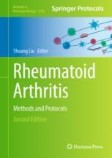Search
Search Results
-
Impact of Drug-Polymer Miscibility on Enthalpy Relaxation of Irbesartan Amorphous Solid Dispersions
PurposeDrug-polymer miscibility has been proposed to play a critical role in physical stability of amorphous solid dispersions (ASDs). The purpose of...

-
Use of Flory–Huggins Interaction Parameter and Contact Angle Values to Predict the Suitability of the Drug-Polymer System for the Production and Stability of Nanosuspensions
PurposeUse of Flory–Huggins interaction parameter and contact angle values to predict the suitability of the drug-polymer system for the production...

-
Amorphization of Low Soluble Drug with Amino Acids to Improve Its Therapeutic Efficacy: a State-of-Art-Review
Low aqueous solubility of drug candidates is an ongoing challenge and pharmaceutical manufacturers pay close attention to amorphization (AMORP)...

-
Rectal and Vaginal Drug Delivery
This chapter provides an overview of dosage forms relevant to rectal and vaginal drug delivery. Barriers to drug absorption are discussed and...
-
The implications of lipid mobility, drug-enhancers (surfactants)-skin interaction, and TRPV1 activation on licorice flavonoid permeability
Licorice flavonoids (LFs) are derived from perennial herb licorice and have been attaining a considerable interest in cosmetic and skin ailment...

-
Revolutionizing Knee Osteoarthritis Treatment: Innovative Self-Nano-Emulsifying Polyethylene Glycol Organogel of Curcumin for Effective Topical Delivery
In the current study, self-nano-emulsifying (SNE) physically cross-linked polyethylene glycol (PEG) organogel (SNE-POG) as an innovative hybrid...

-
Release Enhancement by Plasticizer Inclusion for Amorphous Solid Dispersions Containing High Tg Drugs
PurposePlasticizers are commonly used in the preparation of amorphous solid dispersions (ASDs) with the main goal of aiding processability; however,...

-
HSPiP, Computational, and Thermodynamic Model–Based Optimized Solvents for Subcutaneous Delivery of Tolterodine Tartrate and GastroPlus-Based In Vivo Prediction in Humans: Part I
Tolterodine tartrate (TOTA) is associated with adverse effect, high hepatic access, varied bioavailability, slight aqueous solubility, and short...

-
Long-Term Constant Subcutaneous Drug Administration
In this chapter, a long-term drug delivery system for preclinical therapeutic research is introduced. By using a subcutaneously implanted ALZET®...
-
Scale-Up of Nanoparticle Manufacturing Process
Nanoparticles owning a particle size of less than 100 nm have versatile use in the pharmaceutical industry. Different nanoparticles have been...
-
Optimizing the Formulation of Poorly Water-Soluble Drugs
With as high as 90% of drugs in the development phase and 40% of marketed products exhibiting poor aqueous solubility, the ability to successfully...
-
Exploring Potential Coformer Screening Techniques Based on Experimental and Virtual Strategies in the Manufacturing of Pharmaceutical Cocrystal of Efavirenz
PurposePharmaceutical cocrystals are gaining attention from pharmaceutical industries and researchers because of their applicability, scalability,...

-
Downregulation of pro-inflammatory markers IL-6 and TNF-α in rheumatoid arthritis using nano-lipidic carriers of a quinone-based phenolic: an in vitro and in vivo study
Rheumatoid arthritis (RA) is a joint ailment with multi-factorial immune-mediated degenerative pathogenesis, including genetic and environmental...

-
Hot-Melt Extrusion: from Theory to Application in Pharmaceutical Formulation—Where Are We Now?
Hot-melt extrusion (HME) is a globally recognized, robust, effective technology that enhances the bioavailability of poorly soluble active...

-
Exploration of Abiraterone acetate loaded Nanostructured lipid carriers for bioavailability improvement and circumvention of fast-fed variability
Abiraterone acetate (ABA), a biopharmaceutical class IV drug suffers from solubility and permeability pitfalls resulting in limited oral...

-
Liquid-filled hard capsule formulation of choline alfoscerate: preparation and in vitro/in vivo evaluation
PurposeThe objective of this study was to develop a liquid-filled hard capsule (LFHC) formulation of choline alfoscerate (CA) by screening with empty...

-
Printability of Pharmaceutical Polymers: Issues and Solutions
3D printing offers nowadays great potential for the manufacture of pharmaceutical dosage forms. Despite the advantages provided by this technology,...
-
HSPiP and QbD Program–Based Analytical Method Development and Validation to Quantify Ketoconazole in Dermatokinetic Study
Ketoconazole (KTZ) is the most potential azole anti-mycotic drug . The quantification of KTZ from various layers of the skin after topical application...

-
Investigation of Controlled Release Molecular Mechanism of Oil Phase in Spilanthol Emulsion: Development and In Vitro, In Vivo Characterization
The aim of the present study was to develop a spilanthol emulsion and investigate the effect of oil and drug physicochemical properties on drug...

-
Utility of Films to Anticipate Effect of Drug Load and Polymer on Dissolution Performance from Tablets of Amorphous Itraconazole Spray-Dried Dispersions
Because spray-dried dispersion (SDD) performance depends on polymer selection and drug load, time- and resource-sparing methods to screen...

